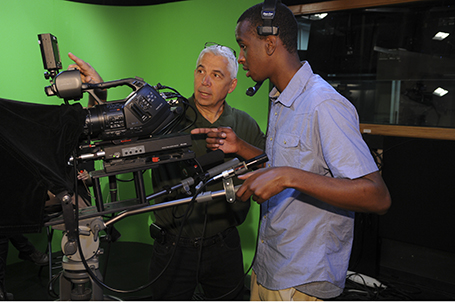Monday, Jan 27, 2014
From education to business to communication, technology plays an essential role in curriculum
by Sam Breccia
Rider prides itself on keeping up with the most current technology to ensure students are developing the proper skill set to be prepared for the real world. The school as a whole, as well as each individual academic department, is proactive about incorporating the newest technological advancements into their programs. Students are taught to use these technologies in a professional manner, which puts them a step ahead of other students who graduated from a college or university that did not focus on the importance of teaching with technology.
Rider’s School of Education has done a lot to prepare future educators for teaching with technology. “The School of Education provides experiences that situate technology use as an instructional resource, we believe that technology should not be viewed as a tool simply for extension of basic skills,” says Sharon Sherman, dean of the School of Education.
Education students use technology in a variety of ways throughout their academic career. The students create electronic portfolios, videotape lessons and analyze them, create teaching websites for field experiences for students and parents of students, create state of the art online math and science courses for teachers, use tutorials, games, writing and publishing centers, learn to use multimedia packages, make electronic presentations, collaborate over networks, use problem solving software and use technology and learning to teach.
“Accessing social media such as Twitter, Instagram and Pinterest is essential for aspiring educators,” Sherman says. “It lets them take advantage of professional opportunities and use outlets to build a personal learning network so they can communicate with their students and the parents of their students.”
The School of Education also offers Professional Development Workshops for students that deal with using different forms of technology for teaching. There are also one credit technology courses students have to take, such as the smartboard course or using technology with literacy.
In the College of Business, the focus is on developing student competency in software skills, since employers find them valuable, says Anne Carroll, associate dean of Undergraduate Programs. “In this era of ‘big data,’ employers are looking for students with solid analytical skills. Being facile with the software that is used to support business analysis is essential in today’s market.”
Carroll says the primary focus is developing students’ Excel skills, adding that all CBA students are required to take a course in the core curriculum that covers Excel. “We are also working to get all of our students familiar with enterprise resource planning (ERP) software as well,” Carroll says. “Further, in several of our research-oriented courses, students use statistical software to analyze data.”
While students in the science departments do not use technology in the same way as education and business students, technology is still a large component in the research conducted by students and faculty. “Doctors Jacobs and Chen, in Chemistry, are working with students on using microwave technology to synthesize new compounds for both drug development and semiconductors,” says Laura Hyatt, associate dean of the College of Liberal Arts and Sciences as well as an associate professor of Biology.
Other forms of technology being used include the Inductively Coupled Plasma Spectrometer to measure small concentrations of elements in water, soil and other new synthesized materials, a Flow Cytometer to look at gene expression, and a technology developed to use with autistic people to look at eye activity and brain function.
As for Communication students, a field where technology is crucial, they are provided with top-of-the-line technology to produce their work. One of the labs in the Fine Arts building was renovated last year. The interior design was redone and three iMacs were placed at each table in the room. There were also televisions hung on the wall above each table to allow students to see each other’s work and collaborate together, as well as a large television placed behind the professor’s desk so he or she can bring up any student’s work to show the whole class.
For Radio/TV majors, the television studio is an important part of their curriculum. The studio opened in 1996 and has been renovated multiple time since then. The most recent renovation took place last year. “The studio received a makeover,” says Scott Alboum, Communications professor. “We upgraded the computers to the latest iMac and installed Final Cut Pro and Avid for the students to use for editing. The switcher and equipment in the control room were also upgraded. Black Magic created our new switcher, which integrates the new HD cameras into the system in a better way. We now have a fully integrated hi-def studio as well as hi-def editing.”
“The University has had a strong commitment to technology throughout my tenure and makes significant annual investments to maintain and enhance technology for instruction, research and general business operations,” says Carol Kondrach, associate vice president of Information Technology. “Technology goals at Rider are established annually based on university strategic goals and technology trends, and set in collaboration with the University's academic leadership. Our focus this year and for the foreseeable future will be to optimize academic and business operations leveraging technology and information to enable the business and improve/enhance services for students."
Today’s dependence on technology will only grow stronger as new advancements continue to be made. Rider is well aware of this and will continue to adapt to and take advantage of new technologies so students can graduate at the cutting-edge.

